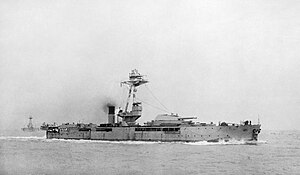Lord Clive class monitor

HMS General Craufurd
|
|
| Class overview | |
|---|---|
| Name: | HMS Lord Clive |
| Operators: |
|
| Preceded by: | Abercrombie class |
| Succeeded by: | Marshal Ney class |
| In commission: | June 1915 - 1927 |
| Completed: | Eight |
| General characteristics | |
| Type: | Monitor |
| Displacement: | 6,150 tons |
| Length: | 335 ft (102 m) |
| Beam: | 87 ft (27 m) |
| Draught: | 9 ft 7 in (2.92 m) |
| Propulsion: | 2 shafts, reciprocating steam engines, 2 boilers, 2,310 hp |
| Speed: | 6.5 knots (12.0 km/h) |
| Complement: | 194 |
| Armament: | Originally two BL 12 inch Mk VIII in a single turret, two QF 3-pounder guns. Lord Clive and General Wolfe had an additional single BL 18 inch Mk I in 1918 installed aft. Similar work on Prince Eugene was not completed because of the end of the war. |
| Armour: |
|
The Lord Clive-class, sometimes referred to as the General Wolfe class, of monitors were ships designed for shore bombardment and were constructed for the Royal Navy during the First World War.
The slow progress of the war led to the need for more shore bombardment ships and various schemes for using spare heavy guns were considered. Heavier guns such as 13.5-inch and 15-inch weapons had no available mountings so the main armament consisted of a single twin 12-inch (305 mm) gun turret taken from decommissioned Majestic-class pre-dreadnought battleships.
The ships were ordered after the Abercrombie class had begun building and the hull form was a near repeat of that design. Extra quick-firing artillery for protection from destroyers and torpedo boats was also fitted in most ships and consisted of up to four six-inch guns.
The Lord Clives, all named after army rather than naval leaders, followed the Abercrombie class of four monitors.
The class consisted of:
Three of the ships, HMS General Wolfe, Lord Clive and Prince Eugene, were to be converted to take the BL 18-inch guns that had originally been allocated to HMS Furious. The guns were mounted aft, permanently arranged to fire over the starboard beam. The mounting consisted of two massive side girders parallel to the barrel, between which the gun was slung. At the forward end was a support about which the gun could train in a limited arc, with a hydraulic cylinder providing ten degrees of traverse each side of the mounting center line. The gun was loaded at the fixed angle of 10 degrees, but firing was only allowed between 22 degrees and 45 degrees of elevation, to distribute the large firing forces evenly between the forward and after supports. The mounting was covered by a large non-traversing half-inch steel plate shield fixed to the deck.
...
Wikipedia
